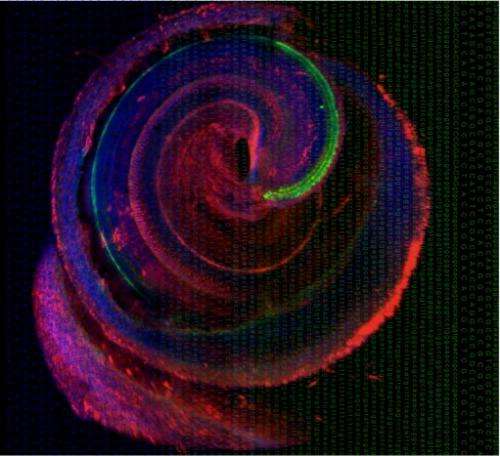Embracing the art of science

Creativity is essential part for both art and scientific investigation. Two Tel Aviv University researchers recently embraced this truth to give birth to a new artwork based on their genetics research—and now it's won a top prize.
The fine arts and the exact sciences may appear an unlikely pair, but creativity is a crucial element in both. Prof. Karen Avraham and PhD candidate Shaked Shivatzki of Tel Aviv University's Sackler Faculty of Medicine embraced this truth when creating Hearing and Deafness: Structure and Sequence, their winning submission to the recent American Society of Human Genetics art competition. Their work was awarded first place and graces the cover of the society's most recent journal.
Their creation uses modern techniques in genetic diagnostics. An image of a mouse cochlea, with cells stained with antibodies to denote the different types of cells and their function in the ear, makes up the background. In the foreground are DNA sequences of a gene that, when mutated, causes deafness, which symbolizes deep sequencing, an advanced technique used to reveal variances in cellular DNA or RNA.
The contest rules were simple, explains Prof. Avraham—create a piece that combines genetics and art to reveal the aesthetic beauty in scientific research. "It's very important to teach the public about science, and one of the ways to do this is to show them the beauty of the field. But a picture is worth a thousand words, and can explain scientific concepts in a clearer way," she said.

Beauty is truth ...
Essentially, the image is a tribute to deep sequencing, a technology used to describe the major components of the human genome, DNA. It's one of the most important tools in genetic diagnostics today, says Prof. Avraham, revolutionizing the hunt for genetic mutations. By finding the mutations responsible for human disease, scientists can diagnose disorders in a way that was impossible before. Israel has been one of the pioneering countries in the use of this technology.
Before deep sequencing, it would take a number of years and millions of dollars to sequence a genome. Now, it takes a matter of weeks, and can be done for the comparatively low cost of about $1,000. Not only does this mean greater access to genetic diagnosis, family planning, and medical management of disorders caused by genetic mutations, it also puts researchers on the right path in terms of developing therapeutic treatment.
The gene featured in the image is called Connexin 26. It is now known that mutations in this gene are the most common cause for deafness, found in about 30 percent of the hearing impaired population in Israel, says Prof. Avraham. Much of the early work in terms of diagnosing this mutation was done in Israel and at TAU, she adds. The study was supported by the National Institutes of Health NIDCD and I-CORE Gene Regulation in Complex Human Disease.
Provided by Tel Aviv University

















